Before I go on any further, I want to clarify a few things as per the purpose of me writing these articles, given the nature of recent interactions with a few fellow FM-ers: my aim is to explore various tactical concepts, understand football as a game through FM as well as to encourage debate and thought around the above issues. I do not ‘present’ game-breaking tactics, and neither do I have to justify anything to anyone but my own morals. Please try to think of what I post in this perspective and I am open to any discussion that will reflect that. There… rant over 🙂
In the last part of this series we discussed the importance of understanding how player roles are conditioned by a number of aspects such as football culture, the team’s tactical set-up and the player’s individual characteristics. The first out of these three is probably the one that has the greatest weight in the widely understood definition of the fantasista. As it is a popular culture term that got molded into the tactical language of the game, that definition is by no means fixed, or referring to an exact set of player qualities. To sum up that overall impression of what a player would need to qualify for the fantasista role we established three key aspects in the last part:
a) tactical intelligence – the ability to read the game, position himself favourably, make decisions that unlock stale pieces of play, trick the opposition, anticipate the opponent’s collective/individual moves
b)imagination/creativity – the ‘fantasy’ brain that comes up with pieces of skill or finds unconventional solutions to complicated situations of the pitch
c) technical ability – the ability to execute the combination of the above two points with the feet: ball control, dribbling, technique, first touch and so on.
The role that I will try to emulate in Football Manager will be based on these three key aspects. Apart from them, I want to integrate the goal-scoring aspect in the role’s style. If you think about players like Del Piero or Baggio, they’re by no means attacking midfielders. Nor are they ‘shadow strikers’ or ‘false nines’. Study closely their movement on the pitch and you will see that these are strikers, however, with a defining aspect in their play that see them roam around the pitch looking to influence the game as much as possible: tactical intelligence. When talking about a technically gifted player, there is no use for him to have a fixed position in an advanced area of the pitch if he can drop deep in the defensive phase and look to link-up players. Alternatively, if the situation created on the pitch allows him to be more efficient in more advanced pockets of space, the fantasista has no restrictions in advancing forward and looking to force a goal-scoring opportunity. As a result, you will have undoubtedly seen Baggio or Del Piero sometimes play behind the main striker, or in front of him, or out wide, or even between the defensive and midfield lines. Remember that most teams rarely stick to their actual 4-4-2 or 3-5-2 (or whatever formation is) shapes over the course of the match, thus the game will present an enormous variety of positional set-ups in different moments. The Fantasista’s role is to assess the situation on the pitch and position himself where he would be most useful.
This is why I used the ‘total attacking’ player term in the last post, as he rarely fulfills defensive duties and his only focus is on having an intelligent, creative and technical impact in the attacking/build-up phases of play.
As this part aims to observe how the three issues mentioned in the opening paragraph (i.e. the context) influence the Fantasista role (i.e. style), let me list the tools that I have at my disposal in FM and how they can help me translate that into the game:
1.football culture – the number 10: the creative, intelligent player that has magic in his feet and brain and roams between and outside the midfield and attacking lines looking to create space, feed team-mates and finish off chances.
Here I have the player’s attributes to help me identify the player for the job. What I would be looking for in terms of stats above everything else:
- technical ability: first touch, dribbling, finishing, technique, passing
- tactical intelligence/creativity: FLAIR 🙂 anticipation, decisions, composure, off the ball, team-work, vision
2.individual characteristics – a fantasista can play in different ways, according to his personal preferences/style/qualities.
Here I would look for a set of specific PPM’s that I believe are the most characteristic to the role I have in mind:
- Tries killer balls often
- Plays one-twos
- Moves into channels
- Comes deep to get the ball
- Curls ball
These are the ideal ones, however I will not use that as a filter for the players/teams I will experiment with as I want to show that fantasistas can be of different profiles.
3. tactical set-up – probably the most important aspect that will condition the player’s role and style of play. For example, if the team is more aggressive, adventurous as a whole, the fantasista will have different responsibilities than in a more conservative set-up. So here we have the whole range of options that the tactical creator allows in order to set-up a playing style. What I would look for above everything else are the following issues:
- maximize the fantasista’s involvement in the attacking phase of play
- adapt the set-up to the player’s characteristics
Apart from these two points, I will look at how the fantasista performs in different shapes/playing styles, as promised in the previous part.
To start with, there is a range of available roles in FM for creative attacking players, however very few fit the bill of my quite complex requirements. As previously mentioned, the role of the Fantasista isn’t a SS, F9, AM or even DLF for that matter. There is however one role that describes pretty much everything I want my player to do in that position:
Although that doesn’t fit all of my criteria – it is the best option I get out of those available. Mind you this is the Trequartista in a striker role. What I’ve found a bit strange is that the TC screen shows him as having a more advanced position than roles like the DLF or even the CF. That needn’t be an issue, as you will notice how deceiving the TC screen can be in terms of telling you where your player will be on the pitch, and most importantly….when.
There are a number of players in the game that fit the role I have in mind, perhaps, ideally we’re talking about Paulo Dybala. Now usually I don’t respond well to or even consider criticism from the FM-base bandwagon that only classify winning the PL with Burnley a tactical success, but for the next experiments I will choose players and teams that are reasonably average just to prove a point. Oh yeah, and if you’ve read until this point and are still waiting for a download link, you can close this tab 😉
The choice for our fist experiment:
the club
the player:
Gremio are a reasonably strong team in Brasil, with more than a couple of really good players in their squad. With a media prediction of 6th, however, they’re not league favorites by any chance. Their key player, and our main man for this project is the above pictured Luan. What makes him so special for this experiment is his unique combination of PPM’s and technical/tactical attributes. All the attributes that I’ve mentioned as being key for the role can be found in abundance on Luan’s profile. Additionally, his PPM’s are the following:
- places shots
- comes deep to get the ball
- plays one-twos
- cuts inside from both wings
- runs with ball often
All in all, we have an interesting profile for the Fantasista role. Straight away, his ‘cuts inside’ and ‘runs with ball’ PPM’s mean that I will look to adapt my set-up to make use of that movement.
Okay, so after a bit of squad analysis, I’ve decided I will play a Diamond 4-1-2-1-2, given that I have really good, hard working midfielders and wing-backs. Additionally, I’ve got a young talent in the name of Lincoln, which I will play in the AM spot with the view of converting him to a trequartista much much later on. (if I will keep playing this save that long, that is)
And on the last note, I chose to employ a diamond to show that the ‘fantasista’ isn’t necessarily the attacking midfielder behind the strikers, as so commonly assumed. Think about Del Piero and Zidane playing together…. which one is the fantasista and which one is the trequartista? 🙂
My tactical set-up will aim to create a style of football that will prioritise passing, work-rate and of course… the Fantasista’s input into the system.
Possible Formation&Roles
The Diamond is a formation uniquely suited for passing football due to the number of triangles it naturally forms, and it can actually be very versatile in its’ applications. The choices I will make in adjusting player roles/positions/instrucions will depend on what I will see on the pitch in my first few matches.
Possible Team Instructions&Shape
The structured shape aims to leave the creative responsibility to the DLP/RGA and the Fantasista (Treq). It is important to remember the effects that team shape has on allowing individual/collective creativity. Ozil-to-the-Arsenal gives the perfect explanation of this issue in one of his wonderful tactical articles:
My interpretation is that shape relates most to how far individual player’s mentality will deviate from your base mentality rather than “compactness / depth”.
Very Fluid = Very low deviation
Fluid = Low deviation
Flexible = Standard
Structured = More deviation
Highly Structured = Much more deviationThere are a few reasons I prefer considering deviation to compactness / depth:
Compactness is a positive term – who doesn’t want their team to be compact?
Team Shape is not the only way to achieve compactness.
An example of a common confusion would be wanting to play a compact, defensive system. Logically, you could select a combination of Defensive mentality for the low-block and mentality, then Very Fluid for the compactness. Given that Very Fluid organises your team as one unit, this sets every player – including strikers and attacking midfielders – to a significantly lower mentality. Very Fluid also gives a higher creative freedom to every player. If you’re playing a defensive system, you’ve probably got more limited players – do you really want to give them a “licence to thrill …. slowly”. Not saying it could never work, but it’s extreme to say the least.
In that sense, a structured shape benefits us in the following ways:
- allows the more creative players (regista&treq) to express themselves more, i.e. deviate from the team mentality and look to stamp their individual quality on the game
- allows for a more spread-out and fixed shape on the pitch, which benefits the passing style I want to create, also allowing me the decision to choose/individually instruct which player I want to be more conservative/adventurous in their style of play
As the wing-backs advance forward, I aim to have the numbers and the shape to create numerical superiority and passing options, as well as having players make themselves available for the pass, hence the ‘roam from position’ instrucion. The ‘use tighter marking’ option aims to bring the AM and the CF/DLF/DF back in our own half when defending, although I will see how that works out. I really want to make the most of Luan’s PPM’s so I will see if I can combine the passing style I want to achieve with having a fair bit of space in front of us for him and the other forward to run into occasionally.
All in all, a pretty Italian way of playing… in Brazil 🙂 When it comes to the Fantasista’s involvement/role, these are the things I want to achieve in this initial experiment:
– connect him with as many players on the pitch as possible while retaining individual attacking threat
– have a set-up that compensates for his lack of deffensive efforts
– make use of his PPM’s in a way that favors the team
It is important to consider that a role like the fantasista is efficient when he has players that he can support as well as the other way around. There is no point having a creative player without other players who will look to make use of his service, so the set-up needs to be mutually beneficial in that sense.
Initial Analysis
Having run a few matches with the first set-up shown above, I can already see a few things that need addressing:
The BWM and Regista occupy the same area on the pitch in both attacking/defensive phases of play. Even worse, the BWM on a defend duty tends to drop down into a central position and leave the left side of the pitch completely depleted of support. Additionally, the Regista, who has a ‘Roam from position’ PI drifts around way too much, given that the TI ‘roam from positions’ enhances that kind of movement even more. What I want for that position is a Pirlo-type of player, as well as someone who doesn’t venture too far forward and stays central to act as a deep passing option. This should enable the left sided CM to offer more support to the left as well. Okay, so first changes are:
- Changed the Regista to a DLP(D)
- Changed the BWM(D) to a BWM(S)
Straight away, I get the desired shape:
What this screen also shows, however, is the BBM not being advanced enough to get involved in the box, as well as not being able to connect with the Fantasista(Treq). Additionally, given his role already has the ‘roam from position’ default instruction, he occasionally drifts out wide, occupying the same position as the RWB at times. Based on that and the fact that I’m noticing us being very susceptible to crosses from wide areas, which means my WB’s are often caught high up the pitch by the opposition wide players, the following changes are made:
- move WB’s to FB position and change role to CWB – this allows them to come back deeper when defending, however maintaining their attacking exploits
- change the left CWB to an ‘attack’ duty, so that he overlaps the DF who has a ‘hold up the ball’ instruction. The space he leaves behind will be covered by the energetic and hard-working BWM
- add ‘get further forward’ instruction to the BBM. This way he connects much better with the Fantasista and the AM, as well as poses another attacking threat. The right CWB, who remains on support duty, maintains a wider and slightly deeper position, thus balancing play nicely on the right flank
These changes have another important effect. As the BBM is now instructed to advance forward, this complements very well with our Fantasista’s tendency to drift out wide and then cut inside from the flank:
The PPM ‘cuts inside’ from both wings is crucial in influencing this type of movement, and having implemented the above changes now we have Luan occasionally drifting out to the right and freeing up space for the BBM and the AM to run forward into. This lateral movement from our fantasista also means our right CWB is much better supported.
Apart from the above mentioned issues, there are another few things that need addressing:
- we perform too many transitions than I would have liked. I want my team to exploit both, the pass&move as well as nicely executed counter-attacks, but I want to focus on the first out of these two, as I feel that would benefit the Fantasista’s tendency to drift around, spray passes and create/exploit space
- the structured shape as well as the BBM getting forward up the pitch result in us being over-stretched at times, leaving the midfield vulnerable to counter-attacks
- the side CM’s aren’t as close to the wings as I want them to be. I want them to perform the mezz’alla role – operate in the half wings and offer support to the CWB’s and the central players.
- we have too many long-shots and I suspect this relates very much to the first of the issues I have mentioned- transitions and support options. We’re often in situations where our most advanced player is still far away from goal and yet he chooses to shoot from distance.
One of the more encouraging parts is the ‘action area’ of the fantasista:
As you can see, pretty much all of his touches happen in the ‘Tre-quarti’ area. Given his PPM’s, he has a tendency to mainly operate in the centre-right. He is involved in the midfield passing to great extent and does exactly what I want him to do in terms of movement too: occasionally dropping deep, or drifting to the flanks, or springing forward to apply the final finish. Now remember why I said the tactical creator screen can be deceiving? 🙂
In the next part we will look at how I will address the above mentioned issues. Hopefully, by the time I get to writing it, I will have played through the State Championship which isn’t much of a challenge for a team of our level. The First Division should be where everything comes under the magnifying glass and when mistakes start to matter more, as well as…. well, success 🙂
Thanks for reading, I hope you enjoy this series and don’t forget to follow me on twitter @LPQR_FM

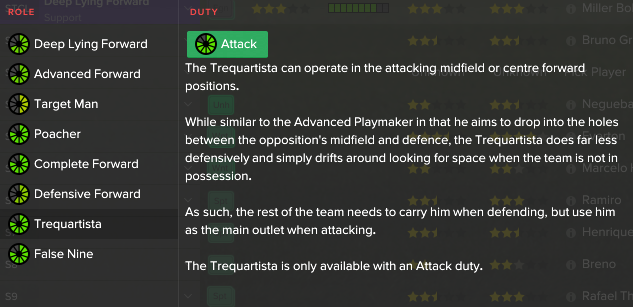
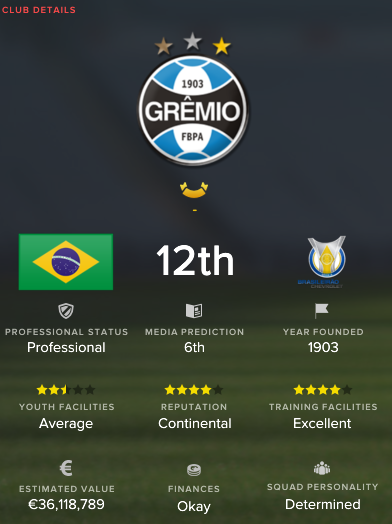
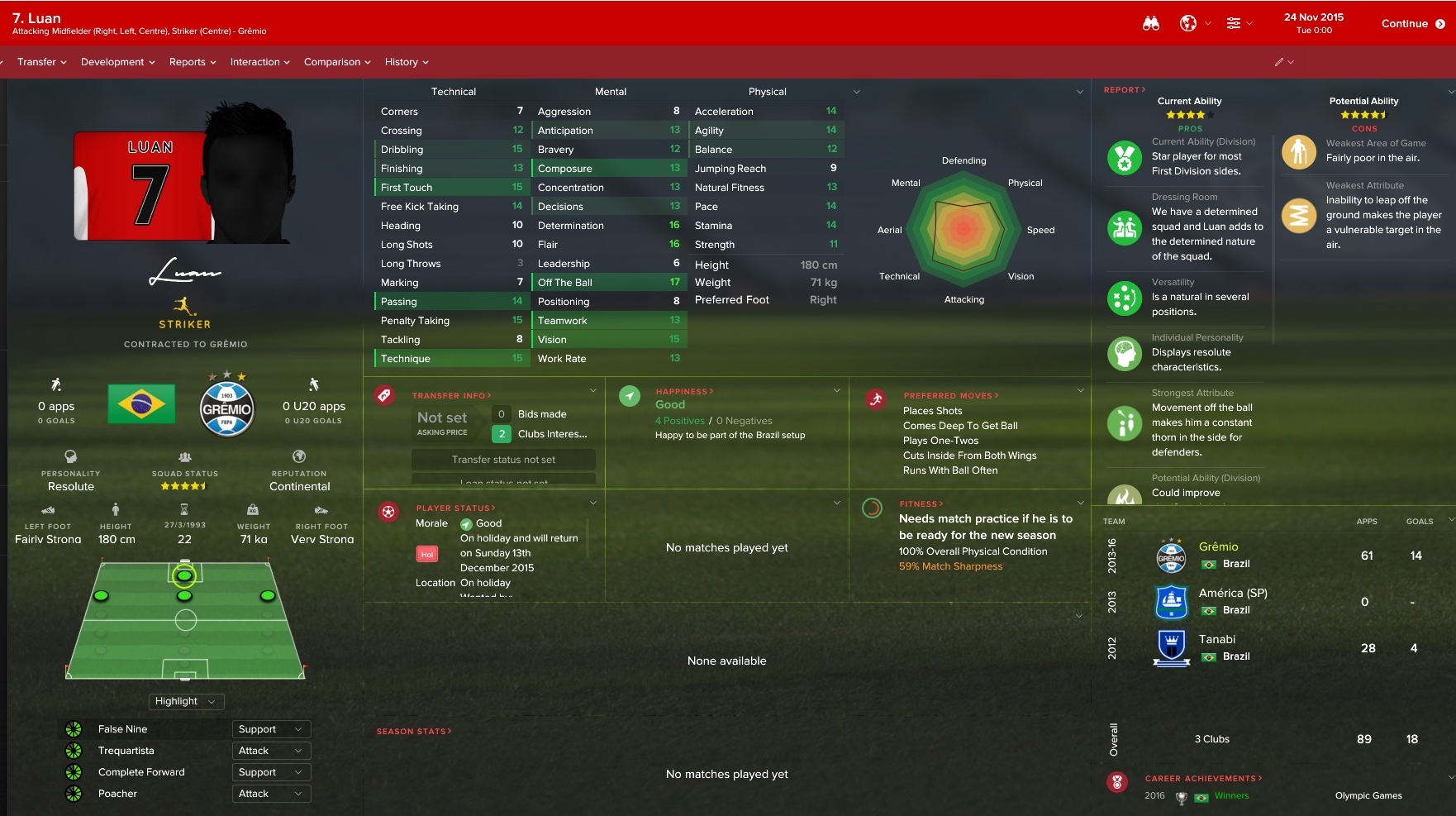
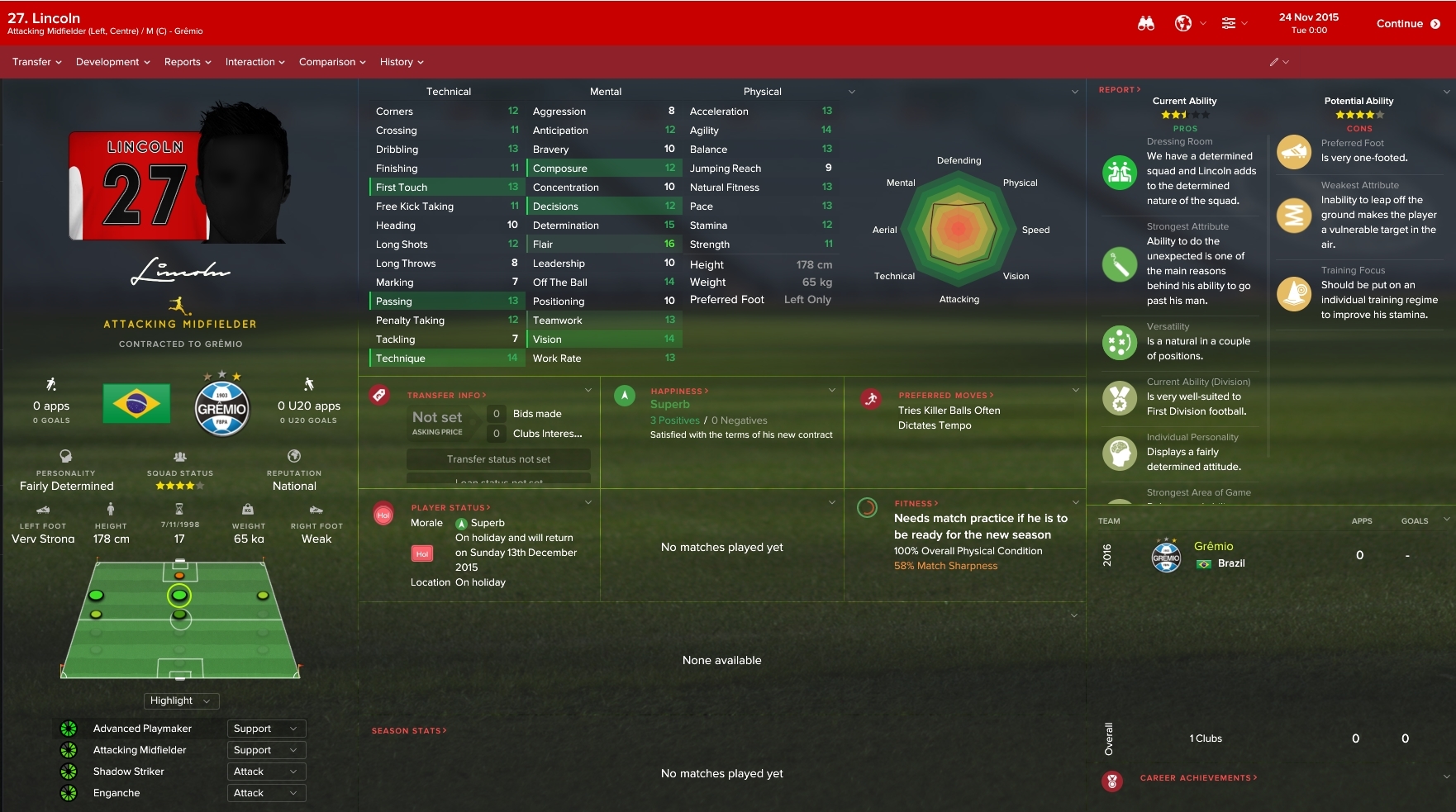
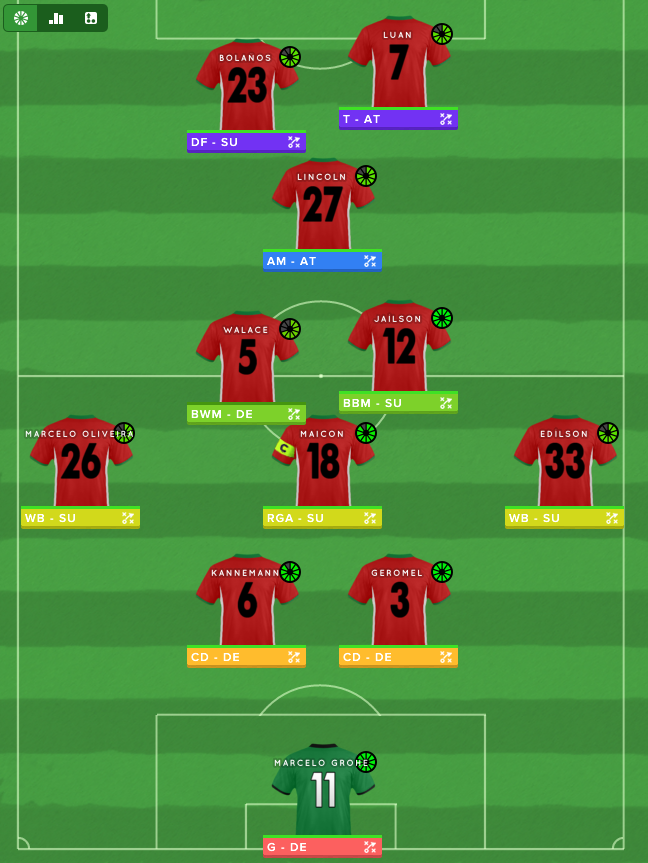
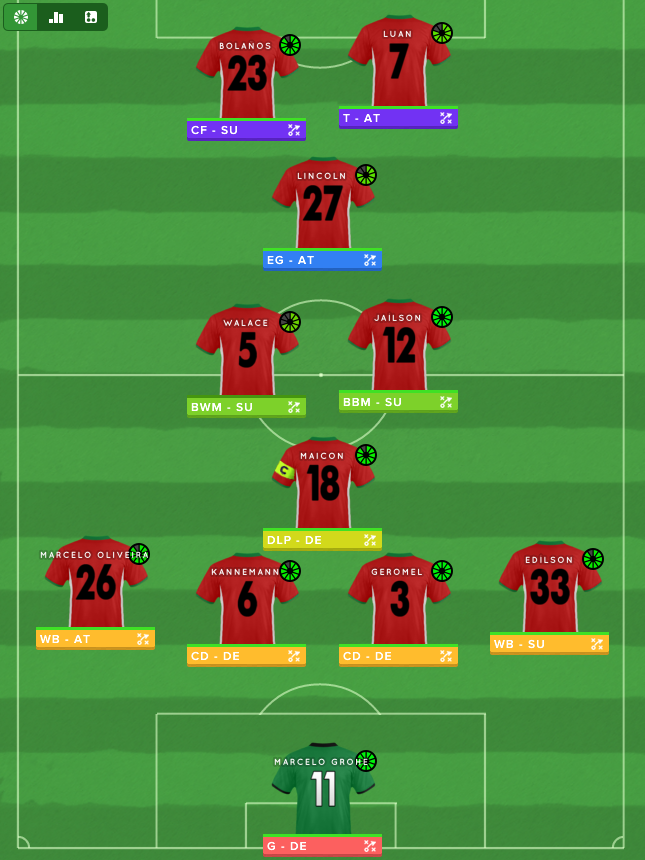

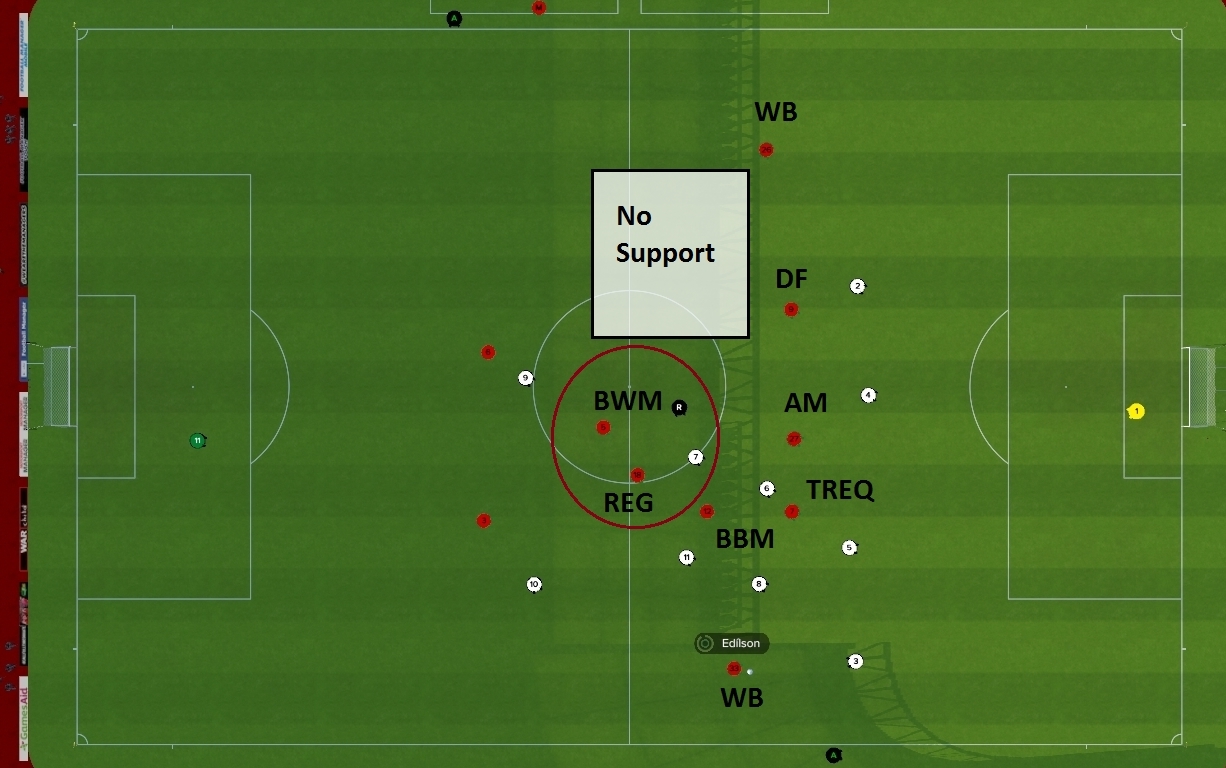
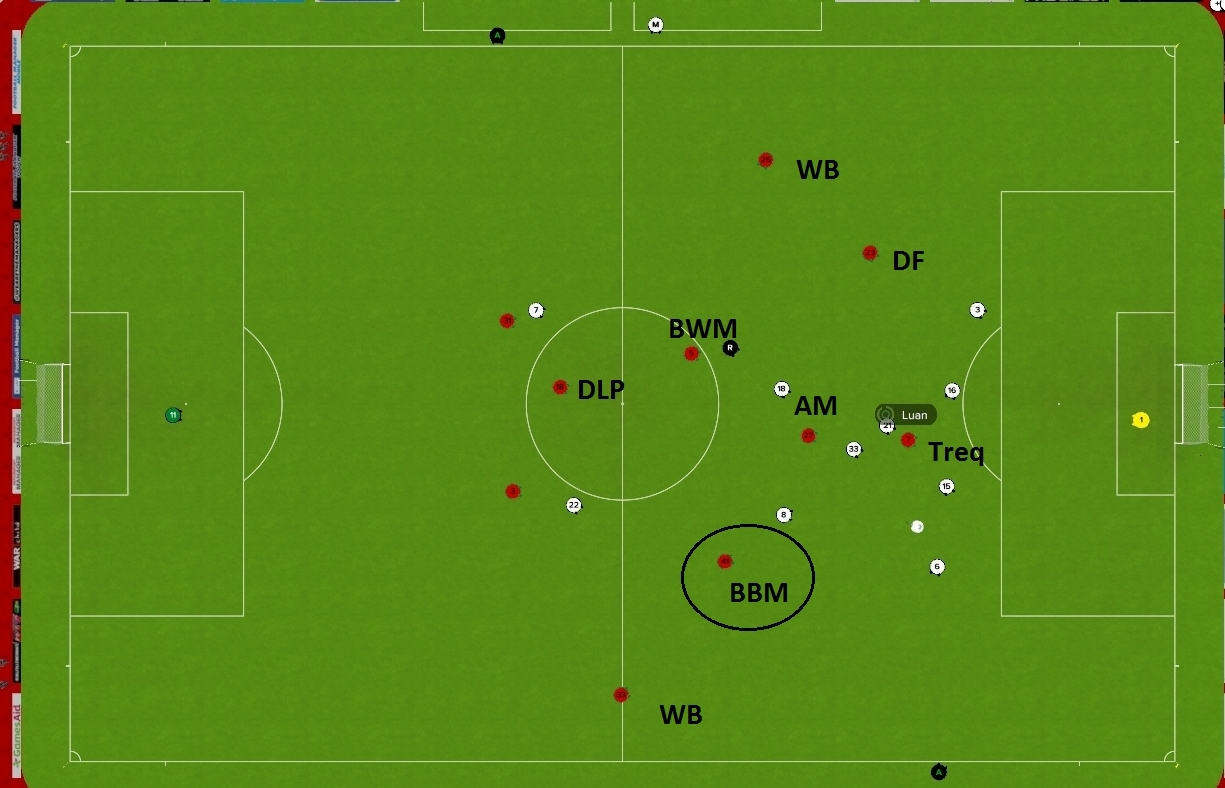
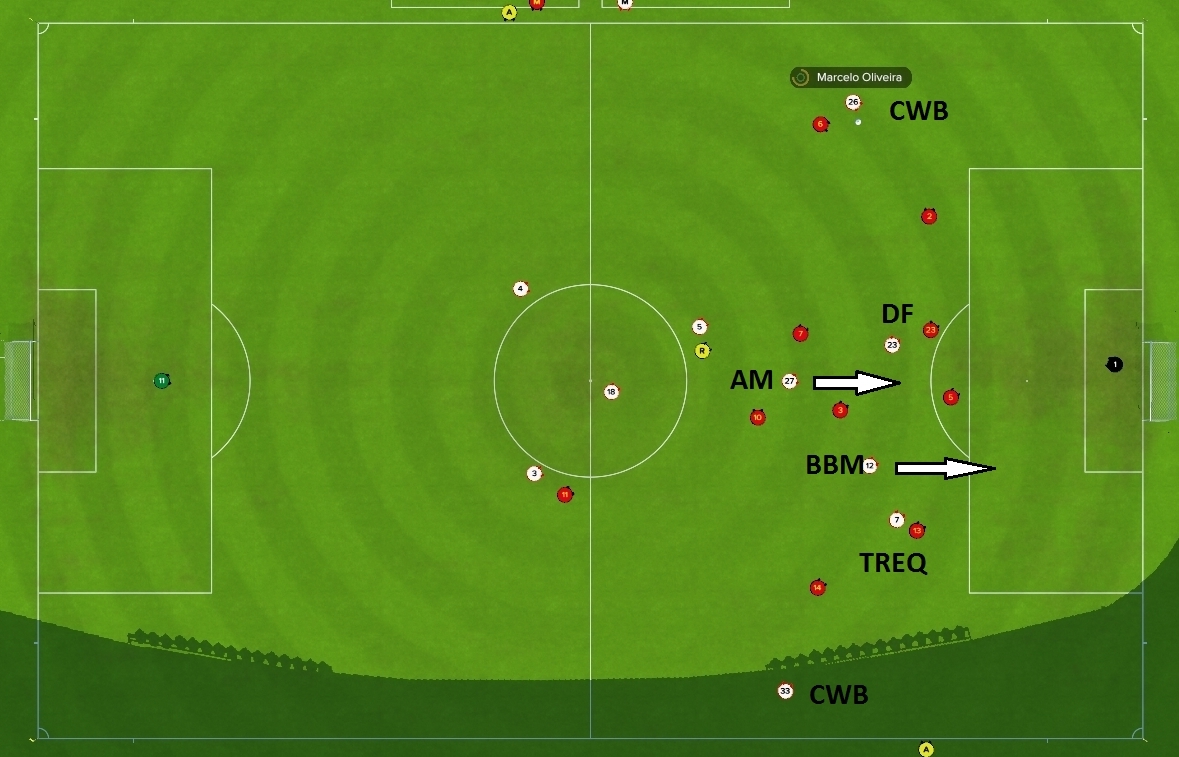
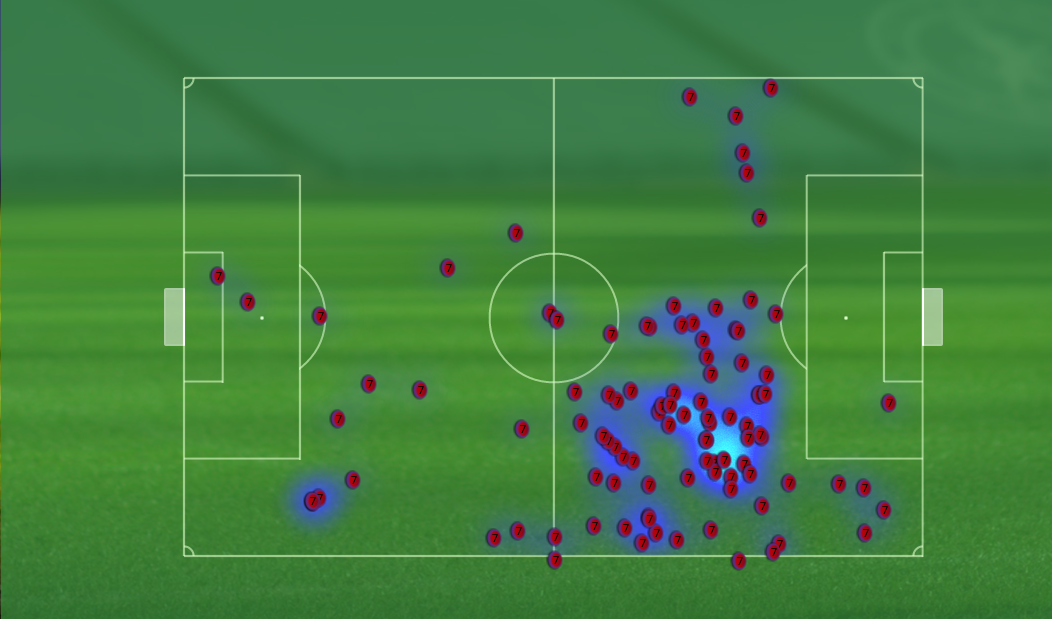
Impressive analysis….love reading your posts….keep them coming.
LikeLike
thanks mate 🙂 probably at a lower pace from now on, but I have a few unfinished projects to keep me in check
LikeLiked by 1 person
Very impressive article and analysis.
The correct italian term is mezzala ( or mezz’ala, less common) or “interno”
LikeLike
Grazie 🙂 I have a tendency to double-letter Italian words for some reason. Yes, mezz’ala made more sense in the context since it’s easier to interpret as ‘mezzo ala’, which relates to the half wing issue I wanted to touch upon. L’interno e un rulo simile ma non identico se lo capisco bene? Non cosi industrioso e molto piu verticale nel muovimento.
LikeLike
You’re right. Similar roles, the two words are often used as synonymous in italy. But, yes the mezzala is meant to be a more hard-working player in general.
LikeLiked by 1 person
Do you expect the fantasista to be the main goalscorer of the team?
LikeLike
I want him to be involved in finishing off chances, but that’s number 3 on the priority list. The first two are that I recreate the movement&behaviour of a fantasista as well as making him as useful as possible to the team, i.e. key passes, created chances, inter-connectivity with other roles and so on 🙂
LikeLike
I asked because players like baggio, but also del piero, mancini and many others, always scored plenty of goals, often more than their attacking partner
LikeLiked by 1 person
Yes, I am aware of that, and I mentioned that is the exact type of player I aim to emulate – a goalscoring fantasista. An often mis-regarded issue is how overall team connectivity helps individual performance. In that sense, if the team has complementary duties/movement on the pitch, that will definitely enable the fantasista to score more 🙂
LikeLike
really solid read, enjoy the stuff you have mate
LikeLike
thanks 🙂
LikeLike
Love this series. Doing something similar with Empoli using a 4-3-1-2. This helped me sort out some roles in the team. Keep them coming!
LikeLiked by 1 person
Stumbled across one of your articles on strikerless and been reading up on your content ever since. Really good stuff. I’m currently trying to emulate this tactic and while I score a ton of goals, I also concede the most. Interested to see if you encounter the same problem going forward and how it can be addressed.
LikeLike
glad you’re enjoying the stuff here 🙂 when it comes to using the same tactics for different teams, I’m usually very much against it for a number of reasons. Most importantly, though, think about it this way: any system I design is in strict co-ordinance with the particularities of the players I have in the squad. Much as you can’t really play tiki-taka with Leicester, or wing-play and target men with Barcelona, I think everything you set-up in your tactics has to have a reason reflected in the squad/player particularities. Hope this helps 🙂
LikeLike